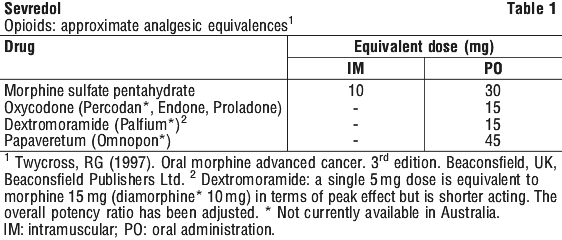Contents
Sevredol is an opioid drug. It is used to combat severe to moderate pain. Due to the narcotic effect of the active substance – morphine – the user must take a number of precautions.
Sevredol – composition and action
Sevredol is a strong pain reliever that belongs to the group of opioid drugs. Coated tablets of the drug are available by prescription. The active substance – morphine (morphine sulphate) has a strong analgesic and sedative effect (increasing sleepiness and reducing anxiety). Morphine is a highly narcotic substance, it stimulates opioid receptors and acts on the central nervous system. In addition, morphine sulphate affects the medulla, inhibiting the activity of the respiratory and cough centers. It increases the tone of smooth muscles, strongly narrows the pupils. A group of opioid drugs, including morphine, can act on the human endocrine system by changing the levels of hormones in the body.
Sevredol – indications
The narcotic effect of the drug means that it can only be used in serious cases. The drug has an analgesic and sedative effect. Sevredol is indicated in cases where pain persists with other weaker analgesics. It is used to combat moderate and severe pain.
Sevredol – contraindications
Sevredol must not be used if the patient is hypersensitive to the active substance or other excipients. The preparation cannot be used in persons:
- with acute abdominal syndrome,
- with paralytic intestinal obstruction (or suspected occurrence of this ailment),
- with acute liver disease,
- with uncontrolled convulsions,
- breastfeeding,
- using MAO inhibitors (morphine can be used only after 14 days from the end of therapy with MAO inhibitors).
Sevredol leaflet – precautions
The package leaflet lists the following situations in which a person taking Sevredol must exercise caution. If you have:
- addiction to opioid drugs,
- disturbances of consciousness,
- breathing disorders,
- severe form of the pulmonary heart,
- low blood pressure,
- reduction of the urethra,
- renal colic
- biliary disorders,
- prostatic hyperplasia and urine retention,
- bowel obstruction,
- intestinal inflammation,
- pheochromocytoma,
- inflammation of the pancreas,
- severe kidney failure,
- severe liver failure,
- seizures
- epilepsy,
- Hypothyroidism,
- severe form of bronchial asthma,
- Chronic obstructive pulmonary disease.
Sevredol – pregnancy and breastfeeding
Sevredol film-coated tablets should not be used during pregnancy unless, in the doctor’s opinion, the benefits of the mother outweigh the likely risks to the fetus. Withdrawal symptoms may develop among newborns whose mothers took opioid medications during pregnancy. The preparation must not be administered to breastfeeding women. Morphine passes into breast milk, where the concentration of the substance can be much higher than in the woman’s blood.
Sevredol – side effects
Side effects may occur in people taking Sevredol. Common and very common side effects include.
Very common: mood swings, constipation, nausea.
Common: decreased appetite, loss of appetite, decreased or increased activity, insomnia, somnolence, cognitive and sensory impairment, headache, abdominal pain, dizziness, muscle spasms, vomiting, anorexia, dry mouth, increased sweating, rash, world, fatigue, malaise, weakness, asthenia, dysregulated urination.
Sevredol – dosage
Dosing is orally, the drug is administered in the form of tablets. The doctor determines the individual dosage of the drug, which depends on the severity of pain, age, disease, reaction to other painkillers, the patient’s state of health and other circumstances. It is important in determining the dose for a patient that this dose is the lowest possible effective dose of the drug. When your pain gets worse, your dose may need to be temporarily increased. The average dose for adults and adolescents over 12 years of age is 10 mg or 20 mg taken every 4 hours. For children from 6 to 12 years of age – 5 mg or 10 mg every 4 hours. For children from 3 to 5 years old – 5 mg every 4 hours. The tablets must be swallowed whole and must not be chewed, broken or chewed by the user.
Sevredol – comments
Morphine can reduce or prevent the ability to drive and use machines. Over time, the dose of the drug should be systematically reduced to avoid the risk of withdrawal syndrome.










